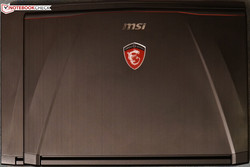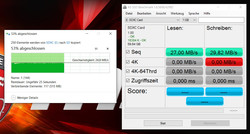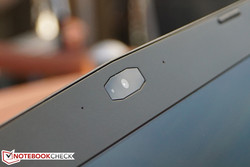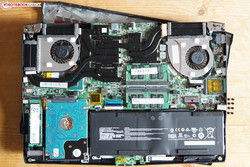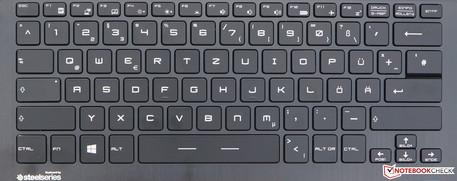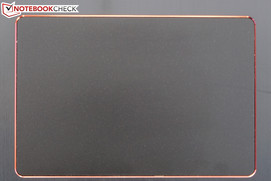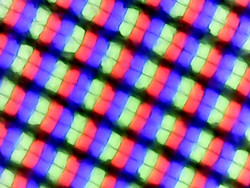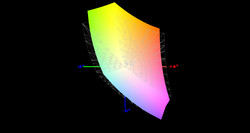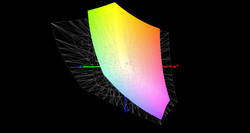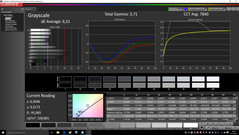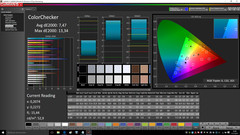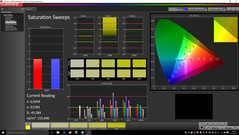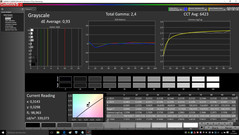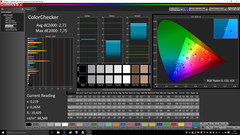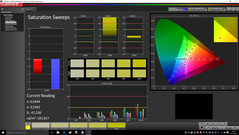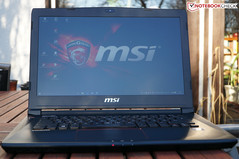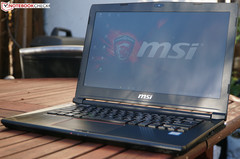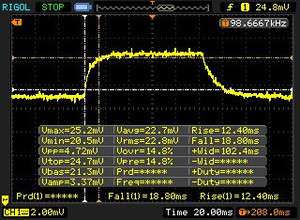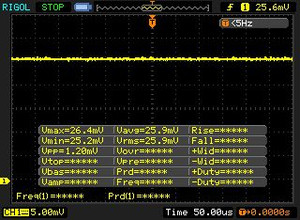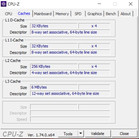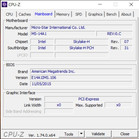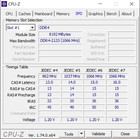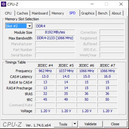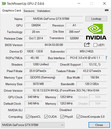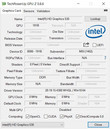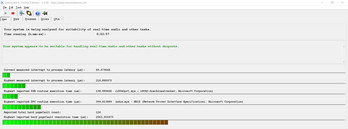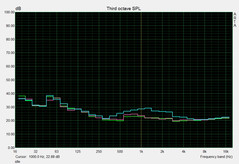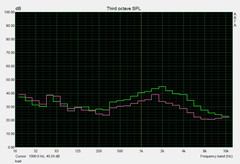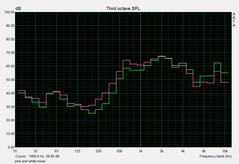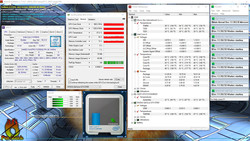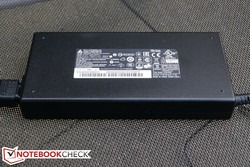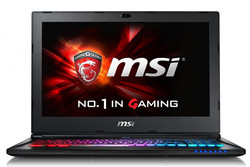MSI GS40 6QE Phantom Notebook Review

For the original German review, see here.
There are not many smaller than 15.4-inch devices that can handle very demanding games. It is easier (and less expensive) to integrate powerful GPUs into larger cases due to the power consumption and heat development. Putting a GeForce GTX 970M in a 14-inch chassis on the other hand, requires more effort in terms of power supply and cooling. MSI has risked it and now offers a 14-inch model that does not have to hide behind the larger rivals, at least not on paper. In addition to the previously mentioned high-end GeForce, you get the following components: Core i7-6700HQ, 16 GB DDR4-RAM and a combination of ultra-fast NVMe-SSD and conventional TB HDD. All this is implemented into a nicely designed chassis that weighs just 1.8 kg (~4 lb) – the price for this package is 1700 Euros (~$1851).
You often read that very compact gaming systems are becoming more popular. The fact that the gaming specialists from MSI have now released a high-end 14-inch gaming notebook could be seen as an indication of this trend, but the GS40 is hardly without rivals. The Gigabyte P34W, for example, uses a similarly sized chassis and both the performance as well as the price are in the same ballpark. We have not received a model with the Skylake update yet, so we use the P34W v3. The latter is also equipped with a GTX 970M, but in combination with a Haswell CPU (Core i7-4720HQ). Obviously, there are performance differences compared to Skylake, but the systems can still be compared when we are not only looking at CPU benchmarks. The same applies for the Schenker XMG C405, which we reviewed in the Haswell configuration with a Core i7-4720HQ and a GeForce GTX 965M.
The ZenBook UX303UB from Asus is a multimedia subnotebook with a 13.3-inch screen, a frugal Skylake dual-core (Core i7-6500U) and a GeForce 940M. The performance is much lower, but on the other hand, the mobility is much better– and you can get it for less than 1000 Euros (~$1089). It might be an interesting alternative if you are willing to make some performance compromises. If you want even more power, however, you should have a look at the Alienware 15 R2. Core i7-6700HQ and GeForce GTX 980M in combination with a 15.6-inch display, available for little more than 2000 Euros (~$2178).
Case
MSI follows the design principles of its gaming lineup. The GS40 also has design features that remind us of a sports car – matte black with few red accents is dominated by the G-series logo. Both the lid and the top of the base are made of brushed aluminum, while the rest of the chassis is made of plastic. This is only a visual difference though – the aluminum dents as easily as the plastic surfaces when we apply pressure.
The display of the GS40 is not very torsion-resistant. Another issue is the display hinges; the panel does not only bounce a lot when you open it, but only stays open when the angle exceeds 10 degrees. This might not be important in practice, but indicates a possible weak spot. At least, there is no creaking and the gaps are very small.
1.8 kg (4 lb) for a powerful gaming device – Gigabyte and Schenker prove that this does not have to affect the stability. The exterior does not suggest a "weak" construction either. The GS40 is not particularly fragile or slim in a direct comparison with the 15-inch MSI GE62, even though all the dimensions are much smaller.
Connectivity
Ports
For its size, the GS40 has a decent port variety. HDMI, two USB 3.0 and one USB 3.1 Type-C (MSI calls it "Super Port") are standard for many modern devices. At the back of the case is also a Mini-DisplayPort; the location is ideal if you want to attach an additional monitor. The port layout at the sides is also very clever: There are no ports at the front, so you are not affected when you use an external mouse.
Card Reader
The card reader is really slow. We can only measure an average transfer rate of 25 MB/s with our reference card (Toshiba Exceria Pro SDXC 64 GB UHS-II). This suggests that the signal still uses the USB 2.0 standard somewhere along the way. Our results were even slightly lower compared to the card reader of the new GE62, where the verdict was: too low for this price range.
Webcam
The camera of the GS40 has 1920x1080 pixels. That the pictures are not razor-sharp should not be a huge problem when you use it as a webcam. The color reproduction is much more important – or do you want to be asked about an unhealthy face color? The camera is actually pretty decent in this respect; the differences compared to the reference picture (taken with a compact camera) are small. Trickier lighting conditions "only" result in a reduction of details in dark areas, but the colors are not affected, both for pictures as well as videos.
Communication
Wired network connections are handled by a Gigabit-Ethernet adapter from Qualcomm Atheros. Wireless connections according to IEEE 802.11ac (867 Mbps) as well as Bluetooth 4.1 are provided by an adapter from the Killer-series. Both 2.4 and 5 GHz connections were strong during our review period and it did not matter whether the notebook was standing directly next to the router or two floors away with several walls in between. A 1 GB video file in the latter scenario was transferred with 13 MB/s on average without any significant fluctuations. There should not be any problems in practice.
Accessories
As well as the usual quick-start guide and the warranty card, the box also includes a driver and software DVD, a keyboard cover as well as a cloth bag for the notebook. Nowadays, you can call this "generous".
Operating System
MSI ships the notebook with a preloaded version of Windows 10 Home 64-bit. The HDD of the notebook contains the recovery partition, which can be used to restore the system and create a USB flash drive for the setup. A Windows DVD is not provided – and cannot be ordered in MSI's shop either, which was still the case for devices based on Windows 7/8.1.
Maintenance
You have to loosen eight screws at the bottom to remove the cover and get access to the internals. One of these screws is covered by the warranty seal, but that is not a problem in Germany. Once the cover is removed you can find one M.2 slot, one 2.5-inch slot as well as two memory slots, but the latter are already used by default. It is also possible to clean the fan or replace the internal battery.
Warranty
MSI offers a warranty of 24 months for its notebooks (battery 12 months) – and the GS40 is no exception. The warranty also includes a free Pick-up & Return service. It is not possible to extend the warranty period.
Input Devices
Keyboard
The GS40 is equipped with a SteelSeries keyboard that has a red background illumination. The construction is similar to the larger MSI gaming notebooks apart from the numeric keypad, which is missing due to space constraints. The typing experience on the other hand, cannot quite live up to the usual qualities. Pressure point and travel are very good, but the whole keyboard will bend even under little pressure on individual keys. This unintended bouncing results in a very spongy typing experience.
Touchpad
The "flexible" surface is not such a big problem for the ClickPad. Clicks will also result in a bouncing pad (as well as half of the keyboard), but this "only" appears a bit cheap and does not really affect the workflow. The gliding capabilities for the fingers are good, and touches and gestures are recognized and executed precisely, even at the edges.
Display
MSI has equipped the GS40 with a 14-inch FHD panel from LG Philips. The matte IPS display manages a decent brightness and a pretty even brightness distribution – the luminance drops slightly only in the two bottom corners. There is no screen bleeding when we look at a completely black picture. The panel holds up pretty well compared to the 14-inch competition, except for one important aspect.
| |||||||||||||||||||||||||
Brightness Distribution: 88 %
Center on Battery: 304 cd/m²
Contrast: 822:1 (Black: 0.37 cd/m²)
ΔE ColorChecker Calman: 7.47 | ∀{0.5-29.43 Ø4.78}
ΔE Greyscale Calman: 6.51 | ∀{0.09-98 Ø5}
86% sRGB (Argyll 1.6.3 3D)
56% AdobeRGB 1998 (Argyll 1.6.3 3D)
62.6% AdobeRGB 1998 (Argyll 3D)
85.7% sRGB (Argyll 3D)
66.2% Display P3 (Argyll 3D)
Gamma: 3.71
CCT: 7840 K
| MSI GS40-6QE16H11 LG Philips LP140WF3-SPD1 (LGD046D), IPS, 14", 1920x1080 | Schenker XMG P406 LG Philips 140WF1 (LGD040A), IPS, 14", 1920x1080 | Gigabyte P34W V3 AU Optronics B140HAN01.1, IPS, 14", 1920x1080 | Schenker XMG C405 AU Optronics B140HAN01.1 (AUO113ED), AHVA, 14", 1920x1080 | Asus Zenbook UX303UB-R4100T ChiMei N133HSE-EA3, IPS, 13.3", 1920x1080 | Alienware 15 R2 (Skylake) Samsung 4NDDJ_156HL (SDC4C48), IPS, 15.6", 1920x1080 | |
|---|---|---|---|---|---|---|
| Display | -2% | 7% | 4% | 6% | -34% | |
| Display P3 Coverage (%) | 66.2 | 66.2 0% | 69.4 5% | 66.8 1% | 66.9 1% | 40.3 -39% |
| sRGB Coverage (%) | 85.7 | 82.8 -3% | 92.6 8% | 89.6 5% | 92.3 8% | 60.2 -30% |
| AdobeRGB 1998 Coverage (%) | 62.6 | 60.5 -3% | 67.4 8% | 65.6 5% | 67.6 8% | 41.67 -33% |
| Response Times | -56% | -86% | -40% | |||
| Response Time Grey 50% / Grey 80% * (ms) | 31 ? | 56 ? -81% | 68 ? -119% | 48.8 ? -57% | ||
| Response Time Black / White * (ms) | 23 ? | 30 ? -30% | 35 ? -52% | 28 ? -22% | ||
| PWM Frequency (Hz) | 178 ? | 200 ? | ||||
| Screen | 15% | -1% | 7% | 20% | -8% | |
| Brightness middle (cd/m²) | 304 | 282 -7% | 305.4 0% | 280 -8% | 385 27% | 180 -41% |
| Brightness (cd/m²) | 282 | 266 -6% | 277 -2% | 267 -5% | 394 40% | 179 -37% |
| Brightness Distribution (%) | 88 | 81 -8% | 84 -5% | 85 -3% | 89 1% | 83 -6% |
| Black Level * (cd/m²) | 0.37 | 0.22 41% | 0.72 -95% | 0.32 14% | 0.41 -11% | 0.19 49% |
| Contrast (:1) | 822 | 1282 56% | 424 -48% | 875 6% | 939 14% | 947 15% |
| Colorchecker dE 2000 * | 7.47 | 4.98 33% | 2.81 62% | 4.75 36% | 3.84 49% | 6.74 10% |
| Greyscale dE 2000 * | 6.51 | 4.08 37% | 1.92 71% | 5.91 9% | 3.79 42% | 6.44 1% |
| Gamma | 3.71 59% | 2.51 88% | 2.21 100% | 2.52 87% | 2.23 99% | 2.29 96% |
| CCT | 7840 83% | 5877 111% | 6384 102% | 5742 113% | 6499 100% | 6465 101% |
| Color Space (Percent of AdobeRGB 1998) (%) | 56 | 54 -4% | 60.4 8% | 59 5% | 60 7% | 38 -32% |
| Color Space (Percent of sRGB) (%) | 86 | 83 -3% | 92 7% | 60 -30% | ||
| Colorchecker dE 2000 max. * | 10.2 | |||||
| Total Average (Program / Settings) | -14% /
2% | 3% /
1% | 6% /
6% | -20% /
2% | -27% /
-18% |
* ... smaller is better
The color accuracy is not ideal ex-works. Average deviations of 6.51 (Grayscale) and 7.47 (ColorChecker) before the calibration are clearly beaten by some rivals, so the result of the GS40 in the table above is quite average. We compared the uncalibrated results to ensure fair conditions between the review units – and the panel cannot quite compensate for the deviations with the high contrast and the decent black value. Calibration can improve the situation significantly: The DeltaE drops to 0.93 (Grayscale) and 2.71 (ColorChecker). The results are vivid colors and richer blacks, so the calibrated display of the GS40 looks quite good.
MSI has now equipped its gaming notebooks with a number of predefined color profiles: You can quickly change the picture settings based on the situation (game, movie playback etc.) via software. Our measurements were performed with the mode "sRGB", which is designed for picture editors and is supposed to provide a high coverage of the corresponding color space. We measured a decent sRGB coverage of 86%, but the AdobeRGB coverage of just 56% will not be sufficient for professional purposes.
The content on the IPS display is easy to see from any angle. Colors do not distort, and this also applies to the brightness when you look at the display from the front. Angles from above or below on the other hand, appear significantly darker, even though the brightness is still sufficient.
Display Response Times
| ↔ Response Time Black to White | ||
|---|---|---|
| 23 ms ... rise ↗ and fall ↘ combined | ↗ 5 ms rise | |
| ↘ 18 ms fall | ||
| The screen shows good response rates in our tests, but may be too slow for competitive gamers. In comparison, all tested devices range from 0.1 (minimum) to 240 (maximum) ms. » 50 % of all devices are better. This means that the measured response time is worse than the average of all tested devices (20.2 ms). | ||
| ↔ Response Time 50% Grey to 80% Grey | ||
| 31 ms ... rise ↗ and fall ↘ combined | ↗ 12 ms rise | |
| ↘ 19 ms fall | ||
| The screen shows slow response rates in our tests and will be unsatisfactory for gamers. In comparison, all tested devices range from 0.165 (minimum) to 636 (maximum) ms. » 40 % of all devices are better. This means that the measured response time is similar to the average of all tested devices (31.6 ms). | ||
Screen Flickering / PWM (Pulse-Width Modulation)
| Screen flickering / PWM not detected | |||
In comparison: 53 % of all tested devices do not use PWM to dim the display. If PWM was detected, an average of 8111 (minimum: 5 - maximum: 343500) Hz was measured. | |||
Performance
The MSI GS40 is only available in one configuration, which we have used for this review (the full designation is GS40-6QE16H11): Intel Core i7-6700HQ, Nvidia GeForce GTX 970M, 16 GB DDR4-RAM and a combination of NVMe-SSD and 1 TB HDD. The performance should be sufficient for almost every modern game in high to ultra details. The graphics output in less demanding situations is handled by the integrated HD Graphics 530 of the processor, which is automatically activated via Optimus and ensures frugal video decoding, for example.
Processor
The Core i7-6700HQ is a mobile high-end CPU from Intel's current Skylake generation. A nominal clock of 2.6 GHz can be overclocked to 3.5 GHz via Turbo Boost (one CPU core) or 3.3 GHz (two cores) and 3.1 GHz (four cores), respectively. You can also use four additional virtual cores thanks to Hyperthreading. The 14 nm manufacturing allows a slight TDP decrease from 47 to 45 watts compared to similar Haswell and Broadwell chips like the Core i7-4720HQ.
If you compare similarly powerful CPUs, in this case Intel quad-cores with a nominal clock of around 2.5 GHz, the differences between the generations Skylake, Broadwell and Haswell are actually not that big. The i7-4720HQ of the Gigabyte P34W is only a few percent points behind its Skylake counterpart in the Cinebench tests. This changes when we look at the ULV processor of the ZenBook UX303 with just two processor cores so, the multi-core performance is significantly lower.
It is not really surprising that our review processor is on par with identical CPUs in other devices like the Alienware 15 R2, for instance. More powerful chips are currently hard to find. The Intel Core i7-6820HK, which is used in several 17-inch models like the MSI GT72S 6QF, is hardly faster by default – but it can be overclocked by the user.
System Performance
The combination of i7 CPU, 16 GB DDR4 memory in a dual-channel configuration, powerful GPU and NVMe system drive ensures the smooth operation of the GS40 in practice. Windows 10 is ready after around 8 seconds; all applications are launched without delays.
A look at the PCMark 8 scores does not reveal a big difference between the Haswell and Skylake platforms. Our review unit as well as the Alienware 15 R2 are sometimes slightly ahead of older systems from Gigabyte or Schenker, and sometimes slightly slower.
| PCMark 7 Score | 5451 points | |
| PCMark 8 Home Score Accelerated v2 | 3776 points | |
| PCMark 8 Creative Score Accelerated v2 | 4742 points | |
| PCMark 8 Work Score Accelerated v2 | 4831 points | |
Help | ||
| PCMark 7 - Score (sort by value) | |
| MSI GS40-6QE16H11 | |
| Schenker XMG P406 | |
| Gigabyte P34W V3 | |
| Asus Zenbook UX303UB-R4100T | |
| Alienware 15 R2 (Skylake) | |
Storage Devices
The Samsung NVMe in our review unit is one of the fastest SSDs you can currently get. The 128 GB drive beats all the competitors in CrystalDiskMark and is even faster than the Samsung PCIe-drive in the Alienware 15 R2. AS SSD determines surprisingly bad results in some of the write tests, but we are not quite sure about the reason. Four seconds is definitely an error – writing operations start without delays in practice. The deplorable write transfer rates with very small files on the other hand, can be reproduced: The Windows Explorer showed 10 MB/s on average when we copied 10000 files in the KB range. You will probably not notice this in practice unless you often copy thousands of small files, but there might actually be a driver issue that is currently being discussed on the Internet.
| MSI GS40-6QE16H11 Samsung MZFLV128 NVMe | Schenker XMG P406 Samsung SM951 MZHPV256HDGL m.2 PCI-e | Gigabyte P34W V3 Lite-On LMT-128L9M | Schenker XMG C405 Crucial M550 CT256M550SSD3 | Asus Zenbook UX303UB-R4100T Micron M600 MTFDDAK512MBF | Alienware 15 R2 (Skylake) Samsung PM951 NVMe MZ-VLV256D | |
|---|---|---|---|---|---|---|
| CrystalDiskMark 3.0 | 20% | -48% | -36% | -44% | -19% | |
| Read Seq (MB/s) | 1332 | 1634 23% | 504 -62% | 517 -61% | 484.2 -64% | 1213 -9% |
| Write Seq (MB/s) | 687 | 1290 88% | 337.4 -51% | 496.6 -28% | 444.9 -35% | 306 -55% |
| Read 4k (MB/s) | 49.57 | 43.82 -12% | 33.13 -33% | 33.03 -33% | 28.74 -42% | 42.62 -14% |
| Write 4k (MB/s) | 138.8 | 110.3 -21% | 75 -46% | 111.3 -20% | 90.5 -35% | 143.7 4% |
| AS SSD | 165% | 64% | 98% | 62% | ||
| Seq Read (MB/s) | 1834 | 1875 2% | 487 -73% | 523 -71% | 514 -72% | |
| Seq Write (MB/s) | 289.1 | 1252 333% | 322.9 12% | 475.6 65% | 399.9 38% | |
| 4K Read (MB/s) | 45.54 | 39.68 -13% | 30.97 -32% | 30.61 -33% | 26.51 -42% | |
| 4K Write (MB/s) | 102.4 | 92 -10% | 67.9 -34% | 97.6 -5% | 76.1 -26% | |
| 4K-64 Read (MB/s) | 738 | 707 -4% | 366.8 -50% | 384.8 -48% | 308.1 -58% | |
| 4K-64 Write (MB/s) | 34.73 | 351.2 911% | 256.3 638% | 304.5 777% | 254 631% | |
| Access Time Read * (ms) | 0.062 | 0.061 2% | 0.094 -52% | 0.063 -2% | 0.11 -77% | |
| Access Time Write * (ms) | 4.234 | 0.042 99% | 0.054 99% | 0.046 99% | 0.064 98% | |
| Total Average (Program / Settings) | 93% /
117% | 8% /
26% | 31% /
53% | 9% /
26% | -19% /
-19% |
* ... smaller is better
GPU Performance
The GeForce GTX 970M is a mobile high-end GPU, which is used in numerous gaming notebooks. The core runs at 924 MHz and 3 GB GDDR5-VRAM are attached via 192-bit memory interface, so the performance should be sufficient for smooth gameplay even in demanding games. Less complex tasks are handled by the integrated HD Graphics 530, which will be activated automatically.
The 3DMark results show that the performance of our review unit is on par with a notebook with the GTX 970M. It does not really make a difference for the 3D performance if the GPU is accompanied by a Skylake, Broadwell or Haswell processor. A GTX 965M, which can be found inside the Schenker XMG C405, falls behind by roughly 25%, while the GeForce 940M in the Asus is 75% slower. The GTX 980M of the Alienware manages between 10 to 25% more points depending on the setting.
The GPU performance is significantly reduced on battery power, even with the "High Performance" power profile. The GTX 970M only runs at a few hundred MHz; the result is only half of the original performance.
| 3DMark 11 Performance | 9544 points | |
| 3DMark Ice Storm Standard Score | 87313 points | |
| 3DMark Cloud Gate Standard Score | 21133 points | |
| 3DMark Fire Strike Score | 6530 points | |
Help | ||
| 3DMark 11 - 1280x720 Performance (sort by value) | |
| MSI GS40-6QE16H11 | |
| Schenker XMG P406 | |
| Gigabyte P55 V4 | |
| Gigabyte P34W V3 | |
| Schenker XMG C405 | |
| Asus Zenbook UX303UB-R4100T | |
| Alienware 15 R2 (Skylake) | |
Gaming Performance
A GeForce GTX 970M can handle pretty much every modern game with great graphics. The “Witcher 3”, for example, is still running smoothly with the "High" preset and the native display resolution. Users of the GS40 should therefore be well-equipped for the current gaming year.
The “Tomb Raider” benchmarks roughly support the synthetic benchmark scores, because both the MSI GS40 and the Gigabyte P34W v3 perform very similarly with the identical graphics card and a different processor. And while the slightly slower GTX 965M (Schenker C405) is often still sufficient for complex games, the 940M even has problems with older games.
| low | med. | high | ultra | |
|---|---|---|---|---|
| Tomb Raider (2013) | 307.5 | 270.3 | 185 | 86.6 |
| The Witcher 3 (2015) | 134.5 | 84.6 | 38.9 | 26.4 |
| Fallout 4 (2015) | 135.5 | 101.3 | 53.5 | 43.7 |
| Tomb Raider - 1920x1080 Ultra Preset AA:FX AF:16x (sort by value) | |
| MSI GS40-6QE16H11 | |
| Gigabyte P34W V3 | |
| Schenker XMG C405 | |
| Asus Zenbook UX303UB-R4100T | |
| Alienware 15 R2 (Skylake) | |
| The Witcher 3 | |
| 1920x1080 High Graphics & Postprocessing (Nvidia HairWorks Off) (sort by value) | |
| MSI GS40-6QE16H11 | |
| Alienware 15 R2 (Skylake) | |
| 1920x1080 Ultra Graphics & Postprocessing (HBAO+) (sort by value) | |
| MSI GS40-6QE16H11 | |
| Alienware 15 R2 (Skylake) | |
| Fallout 4 | |
| 1920x1080 High Preset AA:T AF:16x (sort by value) | |
| MSI GS40-6QE16H11 | |
| Schenker XMG P406 | |
| Asus Zenbook UX303UB-R4100T | |
| 1920x1080 Ultra Preset AA:T AF:16x (sort by value) | |
| MSI GS40-6QE16H11 | |
| Schenker XMG P406 | |
| Asus Zenbook UX303UB-R4100T | |
Emissions
System Noise
The measurements suggest a comparatively quiet gaming notebook – at least no louder than the rivals (except for the ZenBook with its ULV processor). However, the fan behavior can actually be quite annoying in practice. The fans are usually quiet while idling and you can only hear the HDD. But it gets really loud when the GS40 decides to blow off some steam (which happens every few minutes with the "Balanced" power profile) – the fans will quickly reach 38 dB(A).
The cooling solution is usually not running at steady rpm levels under load. Another problem is the pretty high-pitched noise at higher speeds, which adds to the subjective noise impression. At least, our review unit did not suffer from annoying coil whining.
Noise level
| Idle |
| 33 / 34 / 38 dB(A) |
| HDD |
| 34 dB(A) |
| Load |
| 44 / 52 dB(A) |
 | ||
30 dB silent 40 dB(A) audible 50 dB(A) loud |
||
min: | ||
| MSI GS40-6QE16H11 GeForce GTX 970M, 6700HQ | Schenker XMG P406 GeForce GTX 970M, 6700HQ | Gigabyte P34W V3 GeForce GTX 970M, 4720HQ | Schenker XMG C405 GeForce GTX 965M, 4720HQ | Asus Zenbook UX303UB-R4100T GeForce 940M, 6500U | Alienware 15 R2 (Skylake) GeForce GTX 980M, 6700HQ | |
|---|---|---|---|---|---|---|
| Noise | 1% | -2% | -4% | 15% | 4% | |
| Idle Minimum * (dB) | 33 | 30 9% | 34.2 -4% | 29.2 12% | 31.5 5% | 33.6 -2% |
| Idle Average * (dB) | 34 | 32 6% | 34.3 -1% | 34.6 -2% | 31.5 7% | 33.8 1% |
| Idle Maximum * (dB) | 38 | 40 -5% | 38 -0% | 38.8 -2% | 31.5 17% | 34 11% |
| Load Average * (dB) | 44 | 47 -7% | 43.8 -0% | 54 -23% | 35.9 18% | 39.3 11% |
| Load Maximum * (dB) | 52 | 51 2% | 55 -6% | 54.4 -5% | 38.2 27% | 51.4 1% |
* ... smaller is better
Temperature
The GS40 is usually cooler than 40 °C (~104 °F) while idling, but the cooling solution has a hard time to manage the heat under load. One reason is probably the CPU performance, which is hardly affected by throttling and does not drop too far below the nominal clock of 2.6 GHz. This comes at a price though: The chassis warms up to almost 70 °C (~158 °F) over the course of our stress test, which is really demanding for the system. The device does not get quite as hot in practice; however, you should not put it on your lap when you play games. The palm rest stays quite comfortable, even under maximum load.
(-) The maximum temperature on the upper side is 57.4 °C / 135 F, compared to the average of 40.4 °C / 105 F, ranging from 21.2 to 68.8 °C for the class Gaming.
(-) The bottom heats up to a maximum of 68.8 °C / 156 F, compared to the average of 43.2 °C / 110 F
(±) In idle usage, the average temperature for the upper side is 34.1 °C / 93 F, compared to the device average of 33.9 °C / 93 F.
(+) The palmrests and touchpad are reaching skin temperature as a maximum (35.3 °C / 95.5 F) and are therefore not hot.
(-) The average temperature of the palmrest area of similar devices was 28.9 °C / 84 F (-6.4 °C / -11.5 F).
| MSI GS40-6QE16H11 GeForce GTX 970M, 6700HQ | Schenker XMG P406 GeForce GTX 970M, 6700HQ | Gigabyte P34W V3 GeForce GTX 970M, 4720HQ | Schenker XMG C405 GeForce GTX 965M, 4720HQ | Asus Zenbook UX303UB-R4100T GeForce 940M, 6500U | Alienware 15 R2 (Skylake) GeForce GTX 980M, 6700HQ | |
|---|---|---|---|---|---|---|
| Heat | 4% | 9% | 4% | 24% | 16% | |
| Maximum Upper Side * (°C) | 57.4 | 55 4% | 45.2 21% | 47.8 17% | 56.6 1% | 48 16% |
| Maximum Bottom * (°C) | 68.8 | 58.7 15% | 56.8 17% | 60.4 12% | 54.3 21% | 57.3 17% |
| Idle Upper Side * (°C) | 36.3 | 36.9 -2% | 34.6 5% | 37.7 -4% | 24 34% | 31.9 12% |
| Idle Bottom * (°C) | 41.2 | 41.7 -1% | 43.6 -6% | 44.8 -9% | 24.2 41% | 33.4 19% |
* ... smaller is better
Speakers
We are already familiar with the Dynaudio system of the GS40 from other MSI gaming notebooks. Once again, the sound from the stereo speakers is decent, but it lacks some bass. However, a direct comparison with the GE62 shows that the missing subwoofer does not really make a difference. A better sound can be realized with external speakers, which can be attached via the gold-plated stereo jack or HDMI.
Energy Management
Power Consumption
The GS40 is impressive with a pretty low average consumption – while idling as well as under load. The only problem is the very high maximum consumption at over 150 watts, which exceeds the nominal output of the power adapter (not counting the efficiency level). We already know about this problem from many MSI notebooks: The battery will drain under maximum load, even when the power adapter is attached. And once again, we can only repeat that this should not happen in this price range – the small additional costs for a more powerful PSU should not be the problem.
| Off / Standby | |
| Idle | |
| Load |
|
Key:
min: | |
| MSI GS40-6QE16H11 GeForce GTX 970M, 6700HQ | Schenker XMG P406 GeForce GTX 970M, 6700HQ | MSI GS60-6QE4K16H21 GeForce GTX 970M, 6700HQ | Schenker XMG C405 GeForce GTX 965M, 4720HQ | Asus Zenbook UX303UB-R4100T GeForce 940M, 6500U | Alienware 15 R2 (Skylake) GeForce GTX 980M, 6700HQ | |
|---|---|---|---|---|---|---|
| Power Consumption | -5% | -26% | -28% | 59% | -8% | |
| Idle Minimum * (Watt) | 10 | 12 -20% | 17 -70% | 15.8 -58% | 3.2 68% | 11.4 -14% |
| Idle Average * (Watt) | 14 | 16 -14% | 22 -57% | 22.8 -63% | 7.6 46% | 16.5 -18% |
| Idle Maximum * (Watt) | 24 | 22 8% | 28 -17% | 27.3 -14% | 8 67% | 22 8% |
| Load Average * (Watt) | 90 | 90 -0% | 91 -1% | 106.8 -19% | 47 48% | 94.2 -5% |
| Load Maximum * (Watt) | 172 | 170 1% | 149 13% | 152 12% | 55 68% | 192.2 -12% |
* ... smaller is better
Battery Runtime
The battery runtimes of the GS40 are reasonable when you consider the powerful components and the small dimensions. Our realistic Wi-Fi test, which uses a script to open websites at 150 nits, determines a good result of 300 minutes. Sure – ULV-based systems like the Asus ZenBook or 15-inch systems like the Alienware 15 R2 with larger batteries manage longer runtimes. The overall results are, however, quite good within its particular segment (14-inch, high-end components).
| MSI GS40-6QE16H11 GeForce GTX 970M, 6700HQ, 61 Wh | Schenker XMG P406 GeForce GTX 970M, 6700HQ, 45 Wh | MSI GS60-6QE4K16H21 GeForce GTX 970M, 6700HQ, 47 Wh | Schenker XMG C405 GeForce GTX 965M, 4720HQ, 61 Wh | Asus Zenbook UX303UB-R4100T GeForce 940M, 6500U, 50 Wh | Alienware 15 R2 (Skylake) GeForce GTX 980M, 6700HQ, 96 Wh | |
|---|---|---|---|---|---|---|
| Battery runtime | -9% | -26% | -22% | 98% | 84% | |
| Reader / Idle (h) | 5.2 | 4.6 -12% | 3.6 -31% | 16.6 219% | 12.8 146% | |
| H.264 (h) | 5 | 6.9 38% | 7.6 52% | |||
| WiFi v1.3 (h) | 5 | 3.3 -34% | 2.6 -48% | 3.9 -22% | 6.8 36% | 7.4 48% |
| Load (h) | 1 | 1.2 20% | 1 0% | 2 100% | 1.9 90% |
Pros
Cons
Verdict
The GS40 is a good compromise between performance and compact dimensions. The few drawbacks are mainly the result of the "Mini-Max" concept, but you can live with them. The (gaming) performance is beyond any doubt – the GS40 can even handle very demanding games. The display is impressive, the power consumption is reasonable and the battery runtimes are quite good.
The light weight affects the stability of the chassis, which flexes quite quickly under pressure (incl. key strokes). The fans also have a hard time to dissipate the heat – maybe they should just run at a steady rate instead of pulsating? This would definitely improve the noise development.
But this cannot change our good overall impression of the GS40. There are not many 14-inch alternatives, at least if you want modern features like a Skylake CPU, DDR4-RAM and USB 3.1. This could change quite quickly (review of the Schenker XMG P406 will follow soon), but right now you could only go for a smaller, but less powerful system, or get a heavier 15 or even 17-inch gaming notebook.
At around 1700 Euros (~$1851), the GS40 is certainly not a bargain, but the pricing is still similar to the rivals.
MSI GS40-6QE16H11
- 03/08/2016 v5 (old)
Oliver Moebel




